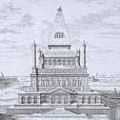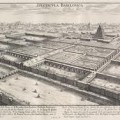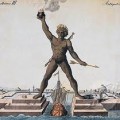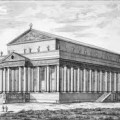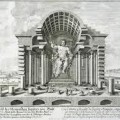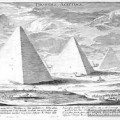- Attached to the essay "Edna’s List"
How two artists 200 years apart rediscovered the lost Wonders
Posted July 28, 2011 8:37 pmBy the end of the Roman Era, all the Wonders except the pyramids had disappeared and only the idea of a List of Seven Wonders survived. For several hundred years no record existed of the original list’s makeup, though new lists continued to be developed. In the early 1500s, after Antipater’s poem had come to light, Von Hemmskerck searched in the libraries of Rome for descriptions of the Wonders and, finding little, made engravings from his imagination. His peculiar rendering of the pyramids, accurate descriptions of which we might expect to have made it to Europe, give a view into the limits of both travel and communication in the 16th century. Nevertheless this one Dutch artist’s engravings were sufficient to restore the List to European consciousness, thanks to their wide distribution and appearance on Mercator‘s popular world map.
Two hundred years later, Johann Bernhard Fischer von Erlach, an esteemed Austrian architect and artist, visited Rome and dug deeper in search of more detailed descriptions of the 7 Wonders. Based on his findings alone, Erlach was able to produce an impressively accurate set of engravings (the Colossus aside)—long before archeology could uncover a factual record of the missing Ancient Wonders. The information had survived, buried in dusty scrolls—an early time capsule—awaiting a future generation with sufficient curiosity.
topics: art
share
 site feed
site feed




